Secretary Bird
- December 17, 2023
- 0 comment
The secretary bird(Sagittarius serpentarius) is a large bird of prey native to the open grasslands and savannahs of sub-Saharan Africa. It is characterized by its striking appearance, with long legs, a distinctive crest of feathers on its head, and a black stripe running down its face. The secretary bird is known for its unique hunting behavior, which involves stomping on prey, such as snakes and insects, with its powerful legs. This bird is part of the family Sagittariidae and is the only living species in its genus, Sagittarius.
Physical Appearance
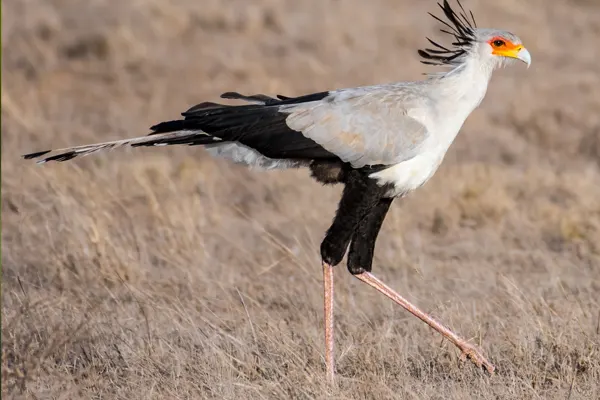
Secretary Bird
- Lifespan: 10 to 15 years
- Habitat: Grasslands
- Diet: Insects, Small Mammals and reptiles.
- Size: 4 to 4.5 feet
- Weight: 2.3 to 4.3 kilograms
- Wingspan: 6 to 7 feet
- Conservation Status: Vulnerable
- Population Trend: Decreasing due to habitat loss, human disturbance.
These physical characteristics make the secretary bird well-adapted to its terrestrial lifestyle and its unique method of hunting. The bird’s appearance is not only distinctive but also serves practical purposes in its natural habitat.
Species Type of Secretary Bird
Scientific name is Sagittarius serpentarius. The secretary bird is the only living species within its genus and family, Sagittariidae, making it a unique and distinctive bird of prey.

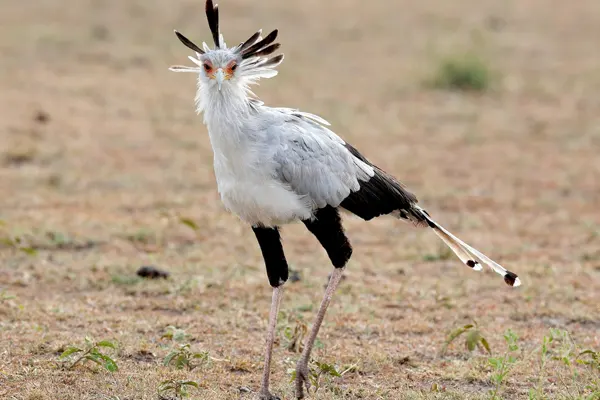
Sexual dimorphism in secretary birds, where males and females have distinct physical differences, is not prominent. In general, both male and female secretary birds look quite similar, and it can be challenging to visually differentiate between the two based on external characteristics alone.
Feather Coloration of Secretary Bird
These differences are very slight and not always reliable for sexing secretary birds. In general, it is difficult to distinguish between male and female secretary birds based on feather coloration alone.
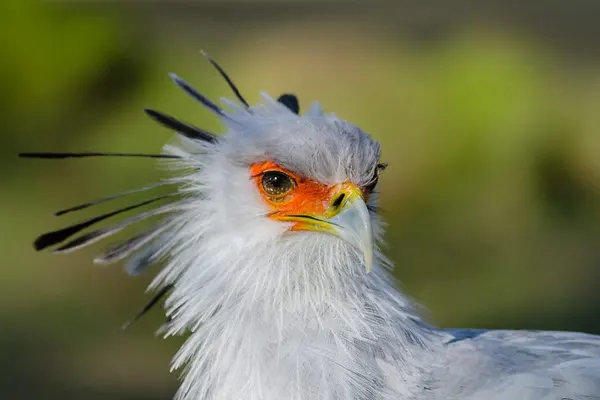
Male
- May have slightly more blue-grey feathers on the upperparts.
- May have a more developed crest with some grey feathers.
- May have proportionately longer central tail feathers.
- May have a more rounded head.
Female
- May have slightly more grey feathers on the upperparts.
- May have a slightly smaller crest with fewer grey feathers.
- May have shorter central tail feathers.
- May have a slightly narrower head.
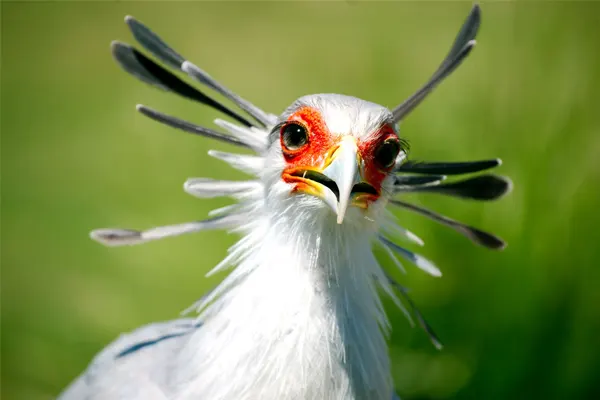
Both male and female secretary birds typically exhibit similar plumage, sharing the characteristic gray and white coloring on their bodies. The wings are black and white, and they have a distinctive crest of long, quill-like feathers on their heads.
Flight Characteristics of Secretary Bird
The secretary bird (Sagittarius serpentarius) is not known for its strong aerial capabilities. While it is capable of flight, it typically prefers to remain on the ground, where it is well-adapted for hunting and walking through its preferred grassland habitats. The flight of the secretary bird is often described as labored and infrequent.
- Preferential Terrestrial Lifestyle: Secretary birds spend the majority of their time on the ground, where they use their long legs to walk and hunt. They are adapted to moving through grassy landscapes in search of prey.
- Limited Flight: Secretary birds are not highly specialized for sustained flight. Their wings are relatively short and rounded, which is indicative of a species adapted for terrestrial activities rather than long-distance flight.
- Takeoff and Landing: When secretary birds do take flight, their takeoffs and landings are often described as somewhat ungainly. They may use a running start to lift off from the ground.
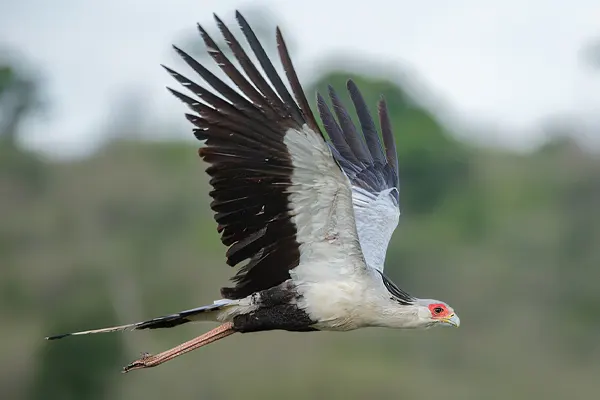
- Soaring and Gliding: While in flight, secretary birds are capable of soaring and gliding, but their flight is generally low and not characterized by long periods of sustained aerial activity.
- Flight for Short Distances: Secretary birds may take to the air to move between different foraging areas or to escape potential threats. However, their flight is typically for short distances.
The secretary bird’s primary mode of hunting involves walking on the ground, and it uses its powerful legs to stomp on prey, especially snakes. The species has evolved to be more specialized for a terrestrial lifestyle rather than for extensive flight.
Migration Patterns of Secretary Bird
The secretary bird (Sagittarius serpentarius) is generally a non-migratory species. It is known for its residency in the open grasslands and savannahs of sub-Saharan Africa throughout the year. Unlike many bird species that undertake long-distance migrations to take advantage of seasonal changes in resources, the secretary bird tends to remain in its preferred habitats.
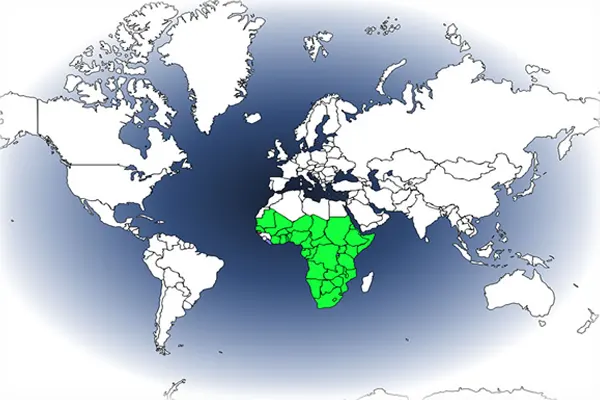

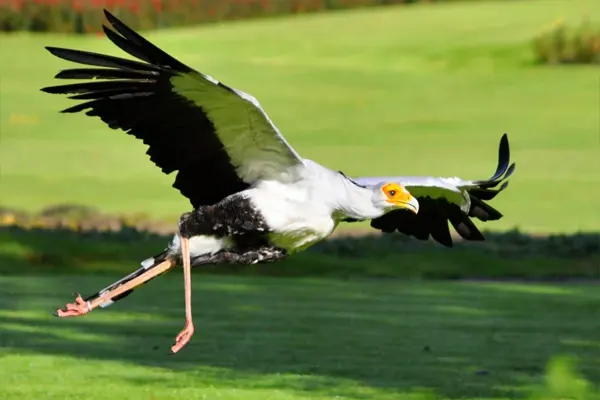
The non-migratory behavior of the secretary bird aligns with its terrestrial lifestyle. These birds are adapted to walking and hunting on the ground, using their long legs to navigate through grassy landscapes. They primarily rely on the availability of prey in their local habitats, such as small mammals, reptiles, and insects.
Habitat & Distribution of Secretary Bird
Secretary birds are typically found in a variety of grassland habitats, including savannahs, open plains, and lightly wooded areas. They prefer regions with tall grasses, which provide cover for their distinctive hunting behavior. These birds are well-adapted to terrestrial life, using their long legs to walk through grassy landscapes in search of prey.
- Open grasslands and savannas: The secretary bird thrives in open areas with tall grasses and scattered trees. This habitat provides them with ample space for hunting their prey and allows them to keep a watchful eye on their surroundings.
- Short grasses: They prefer areas with short grasses, typically one meter or less in height, so their view remains unobstructed while scanning for prey.
- Acacia thorn trees: These trees provide crucial perching and nesting sites for the secretary birds.
- Semi-deserts and scrublands: While not as common, secretary birds can also adapt to these drier environments, searching for suitable hunting grounds.

- Sub-Saharan Africa: Found throughout most of Africa south of the Sahara Desert, excluding the extreme deserts of the Namib coast and the dense rainforests of the Congo Basin.
- Range: Their distribution extends from Senegal in the west to Somalia in the east and South Africa in the south.
- Altitudinal preferences: They can be found from sea level up to around 3,000 meters in altitude.
- Local nomadic movements: While generally non-migratory, they may exhibit local nomadism, following rainfall patterns and the abundance of prey within their range.
The habitat and distribution of the secretary bird, we can better understand its ecological role and implement effective conservation measures to ensure its survival for generations to come.
Behavioral Traits of Secretary Bird
These diverse behavioral traits highlight the remarkable adaptability and ecological significance of the secretary bird. Understanding these behaviors is critical for developing effective conservation strategies to ensure the survival of this magnificent species for generations to come.
- Solitary or paired: Typically found alone or in pairs, with strong bonds forming between breeding partners.
- Cooperative breeding: Both parents share incubation duties and caring for the young.
- Territorial: Pairs defend their territory from other secretary birds, particularly during breeding season.
- Vocalizations: Primarily quiet birds, but they can emit deep croaks, growls, and hissing sounds during territorial disputes or courtship displays.

- Apex predator: Plays a crucial role in controlling populations of rodents, snakes, and other small animals, maintaining the balance of the savanna ecosystem.
- Seed dispersal: Contributes to seed dispersal through their droppings, aiding in plant propagation.
- Charismatic species: Their unique appearance and behavior attract tourists and contribute to ecotourism initiatives, generating income for local communities.
These behavioral traits is crucial for the conservation and management of secretary bird populations, especially in the face of challenges such as habitat loss and human disturbance.
Role in Ecosystem of Secretary Bird
Conserving the ecological role of the secretary bird is essential for maintaining the health and balance of the ecosystems it inhabits. Threats such as habitat loss and human disturbance can impact both the secretary bird and the broader ecosystem, underscoring the importance of conservation efforts.
- Top Predator: As a large bird of prey, the secretary bird holds a position as a top predator in its habitat. It preys on a variety of animals, including snakes, insects, small mammals, and birds. Its ability to hunt and control snake populations is especially notable.
- Control of Snake Populations: The secretary bird is renowned for its effectiveness in controlling snake populations. Its stomping behavior is a formidable method of dispatching venomous snakes, contributing to a natural balance in the ecosystem. By keeping snake numbers in check, the secretary bird helps prevent overpopulation of potentially dangerous species.
- Insect Control: In addition to snakes, secretary birds also feed on a variety of insects. This helps regulate insect populations, influencing the balance of species within the ecosystem.

- Scavenging: Secretary birds are opportunistic feeders and may scavenge on carrion when the opportunity arises. This scavenging behavior contributes to the efficient recycling of nutrients in the ecosystem.
- Nest Site Influence: The construction of large stick nests in trees by secretary birds can have ecological implications. These nests may be used by other bird species, creating a cascade effect in terms of habitat utilization.
- Seed Dispersal: Secretary birds may unintentionally contribute to seed dispersal as they move through different areas. Seeds can adhere to their feathers or be carried in their feces, aiding in the distribution of plant species.
- Cultural and Touristic Value: Beyond ecological roles, secretary birds also hold cultural and touristic significance. They are charismatic species that attract attention, and their presence in natural landscapes contributes to the overall biodiversity value of the area.
The secretary bird plays a vital role in its ecosystem through its diverse interactions with other species, seed dispersal activities, and ecological indicator status. Recognizing and understanding its multifaceted contributions is crucial for implementing effective conservation measures and ensuring the long-term health of the savannas it calls home.
Dietary Habits of Secretary Bird
The stomping behavior employed by secretary birds when hunting snakes is a distinctive and effective adaptation. This behavior not only allows them to deal with potentially dangerous prey but also showcases their specialized approach to hunting. While they are primarily ground-dwelling hunters, secretary birds are capable of flight and may use it to cover larger distances in search of food or to access different foraging areas.
- Snakes: One of the most notable aspects of the secretary bird’s diet is its preference for snakes. The bird is adapted to hunt and eat venomous snakes, and it does so by stomping on them with its powerful legs. This behavior is an effective method of subduing and killing snakes.
- Insects: Secretary birds also consume a variety of insects, including grasshoppers, locusts, beetles, and other arthropods. Insects form an essential part of their diet, especially in areas where they are abundant.
- Small Mammals: The diet of the secretary bird includes small mammals, such as rodents and mammals of a similar size. The bird uses its sharp beak and talons to capture and consume these prey items.


- Birds: While not a primary food source, secretary birds may also prey on small birds, particularly nestlings or injured individuals.
- Reptiles: In addition to snakes, secretary birds may feed on other reptiles, including lizards. They are opportunistic hunters and will consume various prey items depending on availability.
- Amphibians: In some cases, secretary birds may consume amphibians, such as frogs, if they are present in their habitat.
The secretary bird’s diverse diet plays a vital role in maintaining the balance of the savanna ecosystem. By controlling populations of insects, rodents, and snakes, it helps prevent outbreaks and ensures the health of the ecosystem. Additionally, its seed dispersal activities contribute to the spread and diversity of plant life.
Interesting Facts of Secretary Bird
The secretary bird is truly a remarkable creature, captivating with its unique appearance, impressive hunting skills, and crucial role in the savanna ecosystem. Its fascinating facts highlight the importance of protecting this magnificent bird and ensuring its continued presence in the African savanna for generations to come.
- Dust bathing: Regularly dust bathes to maintain their feathers and prevent parasites.
- Snake-killing adaptations: Possesses specialized adaptations for dealing with snakes, including a bony shield on the tarsus to protect from bites.
- Tool use: Occasionally observed using sticks or other objects to probe for prey in burrows or termite mounds.

- Named after its quill-like crest: This crest, resembling the quills used by 18th-century secretaries, gave the bird its distinctive name.
- Largest bird of prey in Africa: Standing up to 1.3 meters tall with a wingspan of 2.1 meters, the secretary bird is the largest avian predator on the continent.
- Long legs and powerful talons: Its long legs allow it to cover vast distances across the savanna, while its powerful talons are perfectly adapted for seizing and killing prey.
- Bare facial skin: The secretary bird’s facial skin can be yellow, orange, or red, adding a splash of color to its overall appearance.
These unique characteristics make the secretary bird a fascinating and distinctive species in the avian world, with a set of adaptations that highlight its role in its natural environment.
Nesting Habits of Secretary Bird
The nesting habits of the secretary bird is essential for conservation efforts, as disruptions to their nesting habitats or disturbances during the breeding season can impact the success of their reproductive endeavors.
- Nest Location: Secretary birds typically build their nests in elevated locations, often choosing acacia trees. The height of the nest helps provide protection against ground predators.
- Nest Construction: Both male and female secretary birds participate in the construction of the nest. The nest is made primarily of sticks and can become quite large and bulky over time.
- Reuse of Nests: Secretary birds may reuse the same nest in successive breeding seasons, making additions and repairs as needed. This behavior can contribute to the development of substantial and durable nests.


- Cooperative Breeding: Secretary birds engage in cooperative breeding, with both partners sharing responsibilities during the nesting period. This includes not only nest building but also incubation of eggs and caring for the chicks.
- Courtship Displays: Before and during the breeding season, secretary birds engage in courtship displays. These displays can involve vocalizations, bill-clattering, and various physical postures. The raised crest on the head may also be part of these displays.
- Egg-laying: After the nest is constructed, the female lays a clutch of typically one to three eggs. The incubation period lasts about 40 to 46 days.
- Parental Care: Both parents take turns incubating the eggs and caring for the chicks. The young secretary birds are altricial, meaning they are born in a relatively undeveloped state and require parental care for an extended period.
The nesting habits of the secretary bird, we can gain valuable insights into their social behavior, reproductive strategies, and the challenges they face in the wild. This knowledge is crucial for implementing effective conservation measures and ensuring the survival of this remarkable species.
Calls & Vocalizations of Secretary Bird
The secretary bird (Sagittarius serpentarius) communicates using a variety of calls and vocalizations. These sounds serve various purposes, including social interaction, courtship, and signaling.
- Hissing Sounds: Secretary birds are known to produce hissing sounds, which can serve as a form of communication. Hissing may be used to express aggression, especially when the bird feels threatened or is defending its territory.
- Bill-Clattering: Secretary birds engage in bill-clattering, a behavior where they rapidly clap their bills together. This can be a form of communication between individuals, and it is often associated with courtship displays or interactions between mates.
- Rattling Calls: Secretary birds may produce rattling or trilling calls, especially during courtship displays or when communicating with their mate. These calls can vary in intensity and duration.

- Contact Calls: Secretary birds use contact calls to communicate with each other, particularly when they are in pairs or family groups. These calls help them stay in contact when foraging or moving through their habitat.
- Alarm Calls: When secretary birds perceive a potential threat or danger, they may emit alarm calls. These calls can alert other individuals in the vicinity to the presence of predators or disturbances.
- Display Calls: During courtship displays or other social interactions, secretary birds may produce specific vocalizations. These calls, along with physical displays such as raised crests, are part of the complex communication associated with breeding behavior.
The vocal repertoire of the secretary bird is diverse, and the context in which the sounds are produced can influence their meaning. Vocalizations play a crucial role in the social dynamics, breeding behaviors, and overall communication within secretary bird populations. Studying these vocalizations contributes to a better understanding of their behavior and ecology.
Conservation Status of Secretary Bird
The secretary bird is a magnificent creature that plays a vital role in the savanna ecosystem. Its current Endangered status highlights the urgency of conservation efforts. By supporting existing initiatives and exploring new opportunities, we can help ensure the future of this remarkable bird and its irreplaceable role in the natural world.
- Habitat Loss: Secretary birds are adversely affected by habitat loss, which occurs due to agricultural expansion, urbanization, and other human activities. As grasslands are converted for other uses, the suitable habitats for secretary birds diminish.
- Human Disturbance: Human activities, including land development, can lead to increased disturbance in the secretary bird’s habitats. This disturbance may impact their nesting sites and overall breeding success.
- Power Line Collisions: Secretary birds are at risk of colliding with power lines, especially in areas where these structures are present. Collisions can result in injuries or fatalities for the birds.
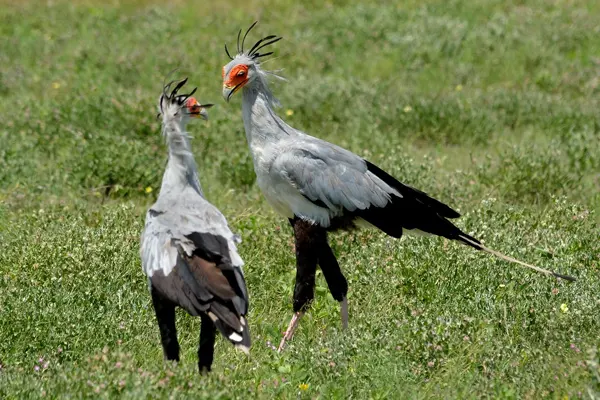

- Poisoning: The use of pesticides and poisoning of rodents in agricultural areas can lead to secondary poisoning of secretary birds. Ingesting poisoned prey can have detrimental effects on their health.
- Climate Change: Changes in climate patterns can affect the availability of prey species and alter the dynamics of secretary bird habitats.
Conservation efforts for secretary birds include monitoring populations, studying their ecology, and implementing measures to mitigate threats. Strategies may involve habitat protection, raising awareness about the importance of the species, and addressing specific threats such as power line collisions. It’s crucial to note that conservation statuses can change, and it’s advisable to check more recent sources for the latest information on the conservation status of the secretary bird.
Research and Ongoing Studies of Secretary Bird
Research plays a crucial role in informing conservation efforts for the secretary bird. By gaining a deeper understanding of their ecology, behavior, and threats, researchers can develop targeted and effective conservation strategies. This research also provides valuable data for monitoring population trends and evaluating the success of conservation interventions.
- Habitat use and selection: Studying how secretary birds use different types of habitats and what factors influence their habitat preferences.
- Diet and foraging behavior: Investigating their feeding habits, prey selection, and seasonal changes in their diet.
- Population dynamics: Estimating population sizes, trends, and factors affecting population growth or decline.
- Movement patterns: Tracking their movements using GPS tags to understand their ranging behavior and migration patterns.
- Impact on prey populations: Evaluating the effects of secretary birds on populations of their prey species.
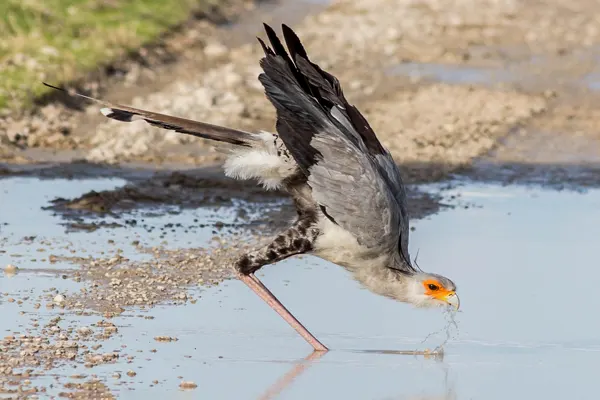
- Social behavior: Studying their social interactions, including pair bonding, breeding behavior, and parental care.
- Communication: Analyzing their vocalizations and other forms of communication to understand how they interact with each other.
- Hunting techniques: Observing and analyzing their unique hunting strategies, such as stomping and kicking prey.
- Cognitive abilities: Investigating their intelligence and problem-solving skills.
- Responses to human activities: Studying how their behavior is affected by human presence, such as agriculture and infrastructure development.
Extensive research is ongoing to improve our understanding of the secretary bird and its conservation needs. This research is essential for ensuring the survival of this magnificent bird and its vital role in the savanna ecosystem.
Educational and Ecotourism of Secretary Bird
Educational and ecotourism initiatives focused on the secretary bird contribute to raising awareness, promoting conservation, and providing learning opportunities for the public.
- Visitor Centers: Establishing visitor centers near secretary bird habitats where educational materials, exhibits, and interactive displays showcase the biology, behavior, and conservation needs of secretary birds.
- Guided Tours: Offering guided tours led by knowledgeable guides who provide information about secretary birds, their role in the ecosystem, and conservation challenges.
- School Programs: Developing educational programs for schools that incorporate field trips, workshops, and presentations to teach students about secretary birds and broader biodiversity conservation.
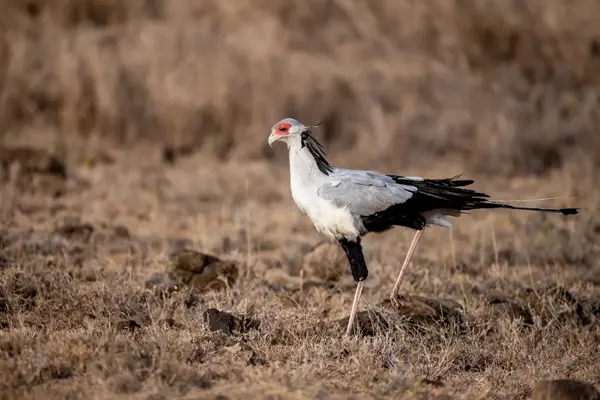
- Conservation Safaris: Developing ecotourism packages that include visits to secretary bird habitats, with a focus on responsible and sustainable tourism practices.
- Conservation Workshops: Providing workshops on responsible tourism practices and the importance of minimizing human impact on secretary bird habitats.
These educational and ecotourism initiatives not only contribute to the conservation of secretary birds but also promote a deeper understanding and appreciation of biodiversity among the public. It’s essential to strike a balance between tourism activities and the well-being of the birds and their habitats to ensure long-term sustainability.
Conclusion
The secretary bird (Sagittarius serpentarius) stands as a remarkable and unique avian species with distinctive features and behaviors. Its long legs, crested head, and specialized stomping hunting technique make it an iconic resident of the grasslands and savannahs of sub-Saharan Africa. Beyond its physical characteristics, the secretary bird plays a crucial ecological role, particularly in controlling snake populations, regulating insect numbers, and contributing to the balance of its ecosystem.
Despite its fascinating traits, the secretary bird faces conservation challenges, leading to its classification as “Vulnerable” on the IUCN Red List. Habitat loss, human disturbance, power line collisions, and poisoning incidents pose threats to its populations. Ongoing research efforts delve into various aspects of the secretary bird’s life, from its nesting habits to its vocalizations, aiming to deepen our understanding and inform effective conservation strategies.
Educational and ecotourism initiatives play a vital role in raising awareness about the secretary bird and fostering a sense of responsibility for its conservation. Through guided tours, interpretive trails, and community involvement, these programs aim to connect people with nature, instilling appreciation and support for the protection of biodiversity.
In the face of conservation challenges, collaborative efforts between researchers, conservation organizations, local communities, and responsible tourists are essential. By combining scientific knowledge with public engagement, there is hope for securing the future of the secretary bird and its ecosystems. Ultimately, the conservation of the secretary bird is not just a matter of preserving a unique species; it is about safeguarding the integrity and balance of the ecosystems it inhabits and sharing the responsibility for the well-being of our planet’s diverse and interconnected web of life.


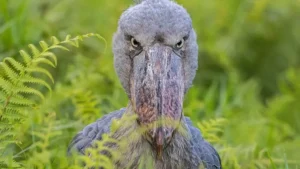
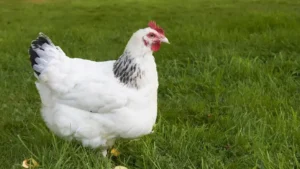
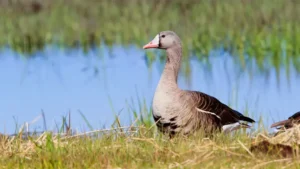
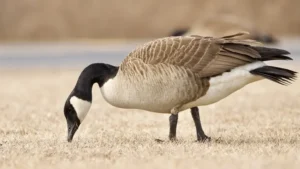
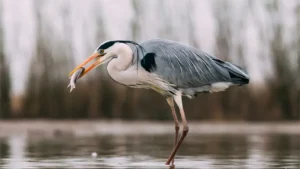
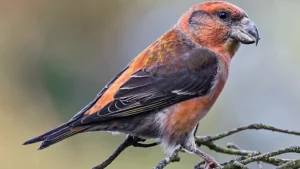
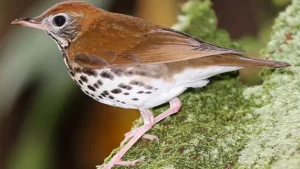
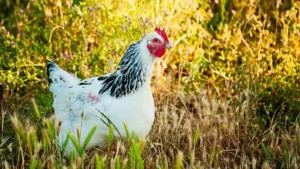


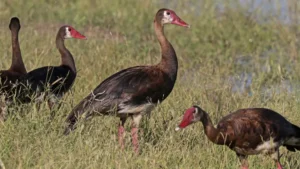
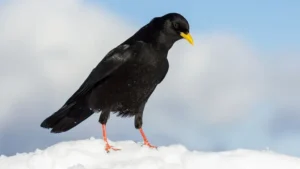
Leave your comment